Ended soon
Given our six-year (and counting) relationship with the Southeast Florida Regional Climate Compact, and our recently launched initiative to support other, similar regional climate collaboratives across the country, we could hardly have put it better than the President’s State, Local and Tribal Leaders Task Force on Climate Preparedness and Resilience recommendations released earlier today:
“Regional organizations […] have developed partnerships and programs that cater to unique regional attributes, natural systems, policy frameworks, governance structures and political realities. For this reason, the Federal Government should work more actively within these existing and emerging frameworks to support resilience and preparedness efforts, while supporting the development of regional frameworks in parts of the country that may not currently have such structures in place. Federal agencies should increase participation with regional organizations and partners and help build capacity to develop best practices and programs tailored to the unique regional impacts of climate change.”
They’re saying that there is no “one size fits all” approach to assessing, preparing for and managing the risks associated with global climate disruption, and thus the Federal Government should work more with the organizations on the ground, and they are right.
Successful adaptation requires collective knowledge of a particular geographic area, followed by coordinated action across multiple sectors and levels of government to develop and carry out solutions that are best suited to that area’s specific challenges and opportunities.
Over the last five-six years regional, multi-jurisdiction approaches to meeting the climate challenge have sprung up across the country, and such collaboratives are proving to be a pragmatic and effective solution to moving the needle on resilience and adaptation.
At least one of the task force members, Vermont Governor Peter Shumlin, witnessed this first-hand as ISC worked with his administration and other stakeholders to develop the Resilient Vermont Project.
Regionalism is a natural and logical step in effective adaptation practice, and like many organic solutions, it faces challenges in terms of institutionalization and replication. For example, how can a multi-jurisdictional collection of individuals built to deal with a unique set of challenges “check the boxes” often required by federal or state institutions? As Local Government Commission Climate Change Program Director Kif Scheuer put it at ISC’s recent Sustainable Communities Leadership Academy (SCLA) workshop titled Think Resiliently, Act Regionally, “[collaboratives] can’t just be a thing, where we’re unformed and unknown, but yet at the same time that’s our power.”
Our workshop brought together 12 regional collaboratives from across the country – some well-established; others just getting started or in the planning stages – to share ideas, experiences, best practices and lessons learned. “Exceptional,” one participant said after the workshop. “Truly motivating. Already spurring new initiatives at home and ongoing conversations with other attendees.”
Mariia Zimmerman, principal of MZ Strategies, reviewed the history of regionalism in the United States. We discussed various successful approaches to regionalism, how these collaboratives can better integrate with the federal government, and how to better communicate – not only with the public, but also across sectors, departments and jurisdictional lines to get the hard work of adaptation done.
We also talked about how these collaboratives can move from resilience planning to resilience implementation. We heard from Fort Lauderdale’s Assistant City Manager Susanne Torriente and the Southeast Florida Regional Climate Compact. She has seen that joint planning allows for the aggregation of local needs creating an efficient approach for state & federal resources, but that the actual implementation piece still often falls to individual municipalities. That implementation can be as simple (or as complex) as changing arcane policies, or language in ordinances that haven’t been touched since Ponce De Leon was in town.
Metropolitan Washington Council of Governments’ Environmental Planner Maia Davis was talking about some of the successes they’ve had working with state and federal entities throughout the district area. Their analysis and planning has been top-down, but implementation had been focused on a bottom-up approach. Similar to Florida – the collaborative’s success arises from providing capacity for individual actors to move towards adaptation.
Nicola Hedge, San Diego Center for Civic Engagement’s Climate Initiative Director talked about how the San Diego Foundation has been a huge champion for work around sea level rise by trying to understand public sentiment, and then doing public outreach focused on key decision-makers in the area. They discovered that 80 percent of decision-makers identified adapting to climate change as important to them, yet those same decision-makers believed that only 20 percent of their peers viewed climate change as a priority. The San Diego Foundation is breaking down that assumption through communication and outreach.
 Ultimately, everyone made strong connections that they can continue to call upon, and I hope that they continue to engage with ISC as they work to create collaboratives that support adaptation and resilience. I encourage anyone interested in establishing a regional approach to the challenges of climate change to visit the resource page from the event, view the videos and read up on what’s working for communities who are on the cutting-edge of multi-jurisdictional approaches to the one of the greatest challenges we face – as cities, as a county and as a global community.
Ultimately, everyone made strong connections that they can continue to call upon, and I hope that they continue to engage with ISC as they work to create collaboratives that support adaptation and resilience. I encourage anyone interested in establishing a regional approach to the challenges of climate change to visit the resource page from the event, view the videos and read up on what’s working for communities who are on the cutting-edge of multi-jurisdictional approaches to the one of the greatest challenges we face – as cities, as a county and as a global community.
Steve Nicholas is ISC’s Vice President of Urban Programs. He is the former Sustainability Director for the City of Seattle and is coauthor of The Guide to Greening Cities.
